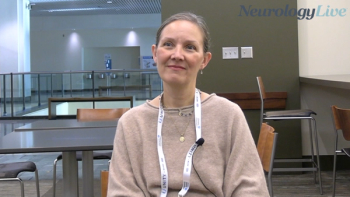
NeuroVoices: Eric Leuthardt, MD, on the IpsiHand Stroke Rehab System
The founder and chief scientific officer of Neurolutions discussed how the company’s newly approved chronic stroke rehabilitation system will provide expanded benefits to post-stroke patients.
In April, the FDA granted de novo authorization, as well as breakthrough device designation, to the first device leveraging brain-computer interface technology to assist patients with chronic stroke in rehabilitation. Neurolutions’ IpsiHand Upper Extremity Rehabilitation System contains a robotic exoskeleton that is worn over the patient’s hand and wrist, an electroencephalogram (EEG)-based headset, and a tablet.
The device utilizes the uninjured, or ipsilateral, side of the brain to improve arm and hand function and is indicated for patients 18 years and older. The use of brain-computer interface technology has become more relevant in recent years, which Eric Leuthardt, MD, feels is potentially an effect from the improvements made in acute care.
Leuthardt, founder and chief scientific offer of Neurolutions, also serves as the division chief of neurotechnology and neurological surgery professor at the Washington University in St. Louis School of Medicine. On a new edition of NeuroVoices, Leuthardt discussed the makeup of the IpsiHand System, why its home-use feasibility may be a huge advantage, and the reasons behind the sudden movement toward these post-stroke rehab systems.
NeurologyLive: What are the clinical tools that make up the IpsiHand System?
Eric Leuthardt, MD: Fundamentally, the IpsiHand System is a brain computer interface technology that consists of a noninvasive biometric EEG headset, a wearable robotic exoskeleton that consists of a dynamic orthosis that’s worn by the patient, and a tablet used to help guide the therapy. Those 3 critical components make up the system.
The science and motivation behind all of this stems from the fundamental idea that things that fire together, wire together. To enhance rehabilitation, we want to retrain the brain to basically recalibrate circuits to optimize function. One of the things that was classically understood before the IpsiHand was that 1 side of the brain controls the opposite side of the body. That bears itself out in a lot of common experiences. If, for instance, somebody had a stroke on the right side, their left side is paralyzed.
What have you found this system to be capable of?
The interesting thing is that you can have movement intentions, or the movement physiology, where the information is encoded, and movement is still present. We found that physiology is present on the uninjured side of the brain. Now, that gives us an opportunity to use brain computer interface, a device that can pick up signals from the brain and decodes those intentions, as a rehabilitation tool. That is 1 of the fundamental theses of this company early on.
The idea is that if we’re using a brain computer interface to pick up a signal of movement intention, or ipsilateral movement signal, where the uninjured side of the brain is controlling the same side of the body. When the signal fires off, it is controlling that robotic exoskeleton, which is giving sensory feedback to the individual, concurrent with those brain signals, that’s going to fundamentally lead to a rehabilitation effect, to enable the brain to better control that paralyzed hand.
First, we were able to show that patients with stroke could do brain computer interface and control a device with those movement intentions from the uninjured side of the brain. We then pair that with a robotic exoskeleton. That actually did indeed have a rehabilitative effect in patients with chronic stroke, who are at least 6 to 8 months out from their stroke and are at a point where the expectation is that they should not get any meaningful clinical benefit. That’s the thinking behind the device and how it works.
What advantages does this system bring to the post-stroke treatment landscape?
There’s a heterogenous cause for disability post-stroke, as well as heterogenous locations of where that injury can occur, whether it be in the white matter, internal capsule, cortex, or even whole hemispheric. By assessing the uninjured side of the brain, we’re acknowledging that the stroke has left you with a motor disability, but that we’re going to tap into the good part of the brain. We’re basically, in some sense, homogenizing that patient population by tapping into these brain signals from the uninjured side to have an effect on improvement. That provides us with an opportunity.
The other thing that gets us excited is that when we publish these papers on brain computer interfacing, they’re typically done in very rarefied controlled laboratory environments. The expectation was that you’re going to use these types of technology, that they had to be in specialized tertiary environments. We’re doing brain computer interface with patients at home. To me, this is a really exciting aspect of this technology.
In addition to the fancy science bells and whistles, equally important is a system that we can send home with you. Patients with stroke can dawn and doth independently, put it on, the system will then walk them through it and screen their brain signals. That was 1 of the key early findings that this system can enable home brain computer interfacing and generate a meaningful clinical result as part of that. Having the ability to have this rehabilitation system that goes in a box at home, meets the patient where they are, and is also a real opportunity for improvement for patients with chronic stroke.
What has driven this growing movement towards these post-stroke rehab systems in recent years?
Firstly, there’s a growing movement in the acute care of stroke. There’s some key aspects whether that’s earlier use of TPA or emerging thrombectomy, that show that we’re getting better with acute stroke in terms of improving outcomes. With that said, there’s still a sizeable number of patients that are left with a motor deficit. Around 300,000 to 400,000 patients per year are left with a chronic upper extremity deficit. We’re expanding our perspective in that we’re maturing our technology for acute intervention, but that’s not the whole story.
How do we start making meaningful strides for people who have gotten past that acute phase? What can we do for them to improve their quality of life? A lot of times people are quite simply resigned to the fact that they’ve got a permanent deficit. The focus, historically, has been adaption and how you can best accommodate that deficit. Now we’re starting to see, especially with brain computer interface, that we can perhaps open that window, again, and start to do things. That’s really starting to generate a lot of excitement for adding to the equation of this global ability to care for these patients.
Transcript edited for clarity.
Newsletter
Keep your finger on the pulse of neurology—subscribe to NeurologyLive for expert interviews, new data, and breakthrough treatment updates.


































